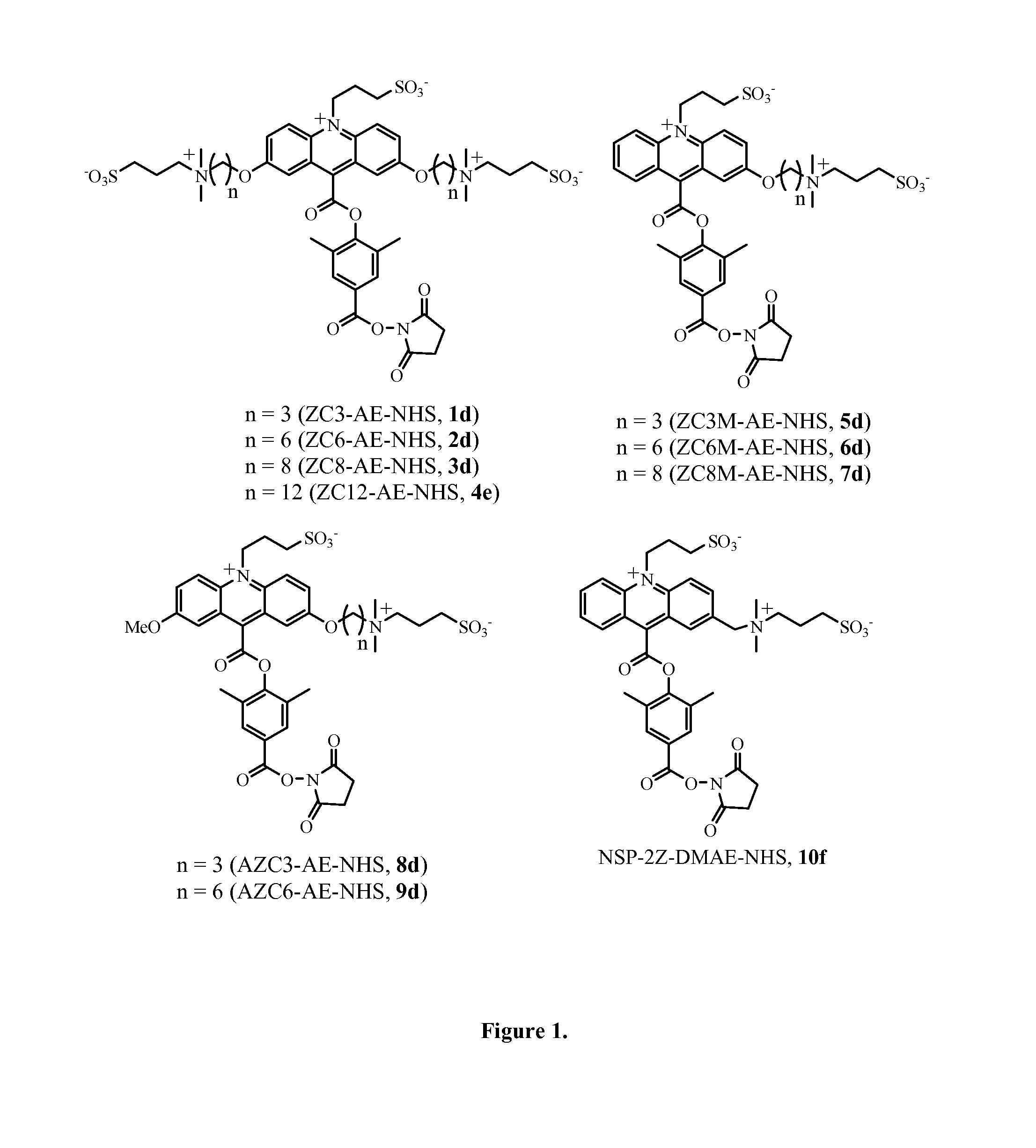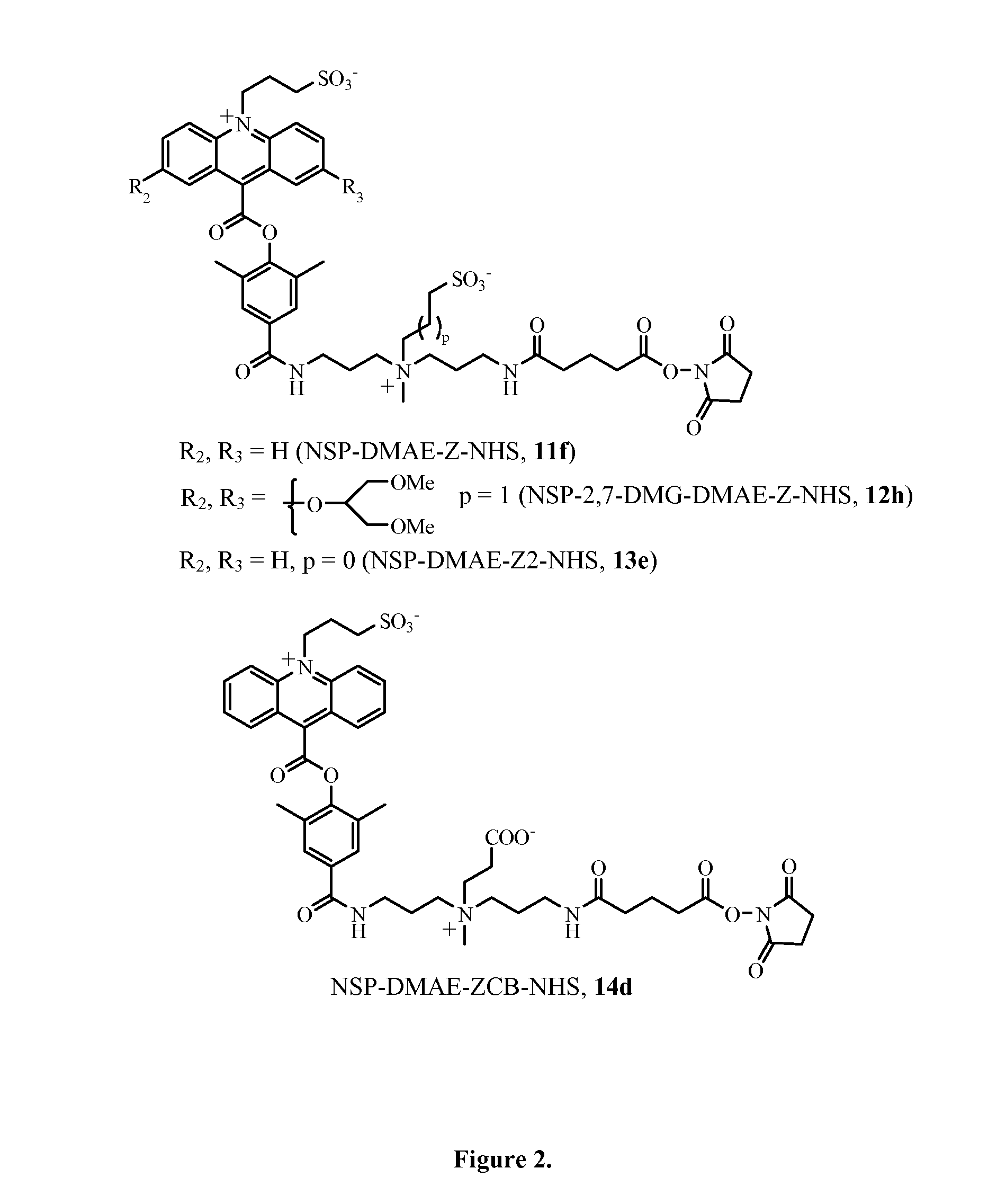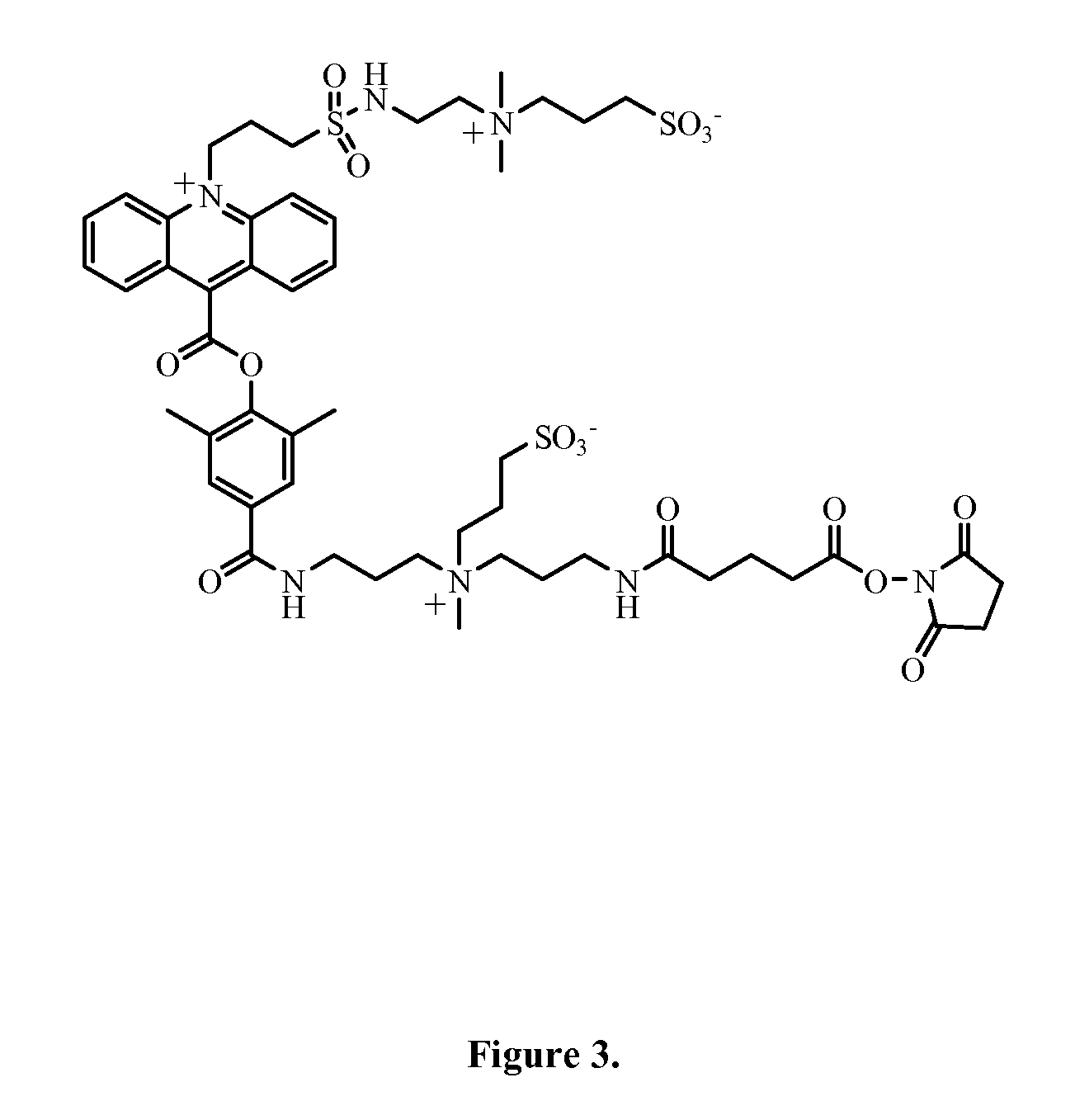Zwitterion-containing acridinium compounds
a chemiluminescent and acridinium compound technology, applied in the field of zwitterion-containing acridinium compounds, can solve the problems of reducing the sensitivity of the assay, limiting the commercial utility of the assay, and reducing the signal to background ratio, so as to improve the properties of the chemiluminescent acridinium compound, reduce non-specific binding, and increase the hydrophilicity
- Summary
- Abstract
- Description
- Claims
- Application Information
AI Technical Summary
Benefits of technology
Problems solved by technology
Method used
Image
Examples
example 1
Synthesis of ZC3-AE-NHS, Compound 1d
[0181]a) Compound 1a
[0182]A solution of 2,7-dihydroxy acridine methyl ester, (0.1 g, 0.24 mmol), (U.S. Pat. No. 7,309,615), 3-dimethylaminopropanol (0.112 mL, 4 equivalents) and triphenylphosphine (0.252 g, 4 equivalents) in anhydrous tetrahydrofuran (10 mL) was treated with diisopropyl azodicarboxylate (0.188 mL, 4 equivalents) under a nitrogen atmosphere. The reaction was stirred at room temperature for 16 hours. TLC analysis on silica using ethyl acetate as eluent showed no starting material and using 75% ethyl acetate, 24% methanol and 1% triethylamine, a polar product (Rf ˜0.15) was observed. The solvent was then removed under reduced pressure and the residue was partitioned between 1N HCl (25 mL) and ethyl acetate (25 mL). The aqueous layer containing product was extracted two more times with ethyl acetate (2×25 mL). The acidic aqueous layer was then treated with 2.5% aqueous sodium hydroxide drop wise until a bright yellow suspension was fo...
example 2
Synthesis of ZC6-AE-NHS, Compound 2d
[0188]a) Compound 2a
[0189]A solution of 2,7-dihydroxy acridine methyl ester, (30 mg, 72 umoles), 6-dimethylamino-1-hexanol (42 mg, 4 equivalents) and triphenylphosphine (75 mg, 4 equivalents) in anhydrous tetrahydrofuran (5 mL) was treated with diisopropyl azodicarboxylate (0.06 mL, 5 equivalents). The reaction was stirred at room temperature under a nitrogen atmosphere for 16 hours. TLC analysis on silica using 70% ethyl acetate, 28% methanol, 2% triethylamine showed clean conversion to a polar product. HPLC analysis of the reaction mixture was performed using a Phenomenex, C18 4.6 mm×25 cm column and a 30 minute gradient of 10→70% B (A=water with 0.05% TFA, B=MeCN with 0.05% TFA) at a flow rate of 1.0 mL / minute and UV detection at 260 nm. Product was observed eluting at Rt=25 minutes and was the major component. The product was isolated as described in Example 1, section (a). Yield=36 mg (75%).
[0190]b) Compound 2c
[0191]A mixture of compound 2a (...
example 3
Synthesis of ZC8-AE-NHS, Compound 3d
[0195]a) Compound 3a
[0196]A solution of 2,7-dihydroxy acridine methyl ester, (30 mg, 72 umoles), 8-dimethylamino-1-octanol (50 mg, 4 equivalents) and triphenylphosphine (75 mg, 4 equivalents) in anhydrous tetrahydrofuran (5 mL) was treated with disopropyl azodicarboxylate (0.06 mL, 5 equivalents). The reaction was stirred under a nitrogen atmosphere for 16 hours. HPLC analysis of a small portion of the reaction mixture was performed using a Phenomenex, C18 4.6 mm×25 cm column and a 30 minute gradient of 10→100% B (A=water with 0.05% TFA, B=MeCN with 0.05% TFA) at a flow rate of 1.0 mL / minute and UV detection at 260 nm. Product was observed eluting at Rt=22.5 minutes and was the major component. The product 3a was isolated as described in Example 1, section (a). Yield=58 mg (quantitative), MALDI-TOF MS 728.6 observed.
[0197]b) Compound 3c
[0198]A mixture of compound 3a (58 mg, 80 umoles), distilled 1,3-propane sultone (0.291 g, 30 equivalents) and 2,...
PUM
 Login to View More
Login to View More Abstract
Description
Claims
Application Information
 Login to View More
Login to View More - R&D
- Intellectual Property
- Life Sciences
- Materials
- Tech Scout
- Unparalleled Data Quality
- Higher Quality Content
- 60% Fewer Hallucinations
Browse by: Latest US Patents, China's latest patents, Technical Efficacy Thesaurus, Application Domain, Technology Topic, Popular Technical Reports.
© 2025 PatSnap. All rights reserved.Legal|Privacy policy|Modern Slavery Act Transparency Statement|Sitemap|About US| Contact US: help@patsnap.com



